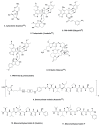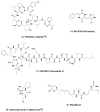Marine-sourced anti-cancer and cancer pain control agents in clinical and late preclinical development
- PMID: 24424355
- PMCID: PMC3917273
- DOI: 10.3390/md12010255
Marine-sourced anti-cancer and cancer pain control agents in clinical and late preclinical development
Abstract
The marine habitat has produced a significant number of very potent marine-derived agents that have the potential to inhibit the growth of human tumor cells in vitro and, in a number of cases, in both in vivo murine models and in humans. Although many agents have entered clinical trials in cancer, to date, only Cytarabine, Yondelis® (ET743), Eribulin (a synthetic derivative based on the structure of halichondrin B), and the dolastatin 10 derivative, monomethylauristatin E (MMAE or vedotin) as a warhead, have been approved for use in humans (Adcetris®). In this review, we show the compounds derived from marine sources that are currently in clinical trials against cancer. We have included brief discussions of the approved agents, where they are in trials to extend their initial approved activity (a common practice once an agent is approved), and have also included an extensive discussion of the use of auristatin derivatives as warheads, plus an area that has rarely been covered, the use of marine-derived agents to ameliorate the pain from cancers in humans, and to act as an adjuvant in immunological therapies.
Figures
References
Publication types
MeSH terms
Substances
LinkOut - more resources
Full Text Sources
Other Literature Sources
Medical




